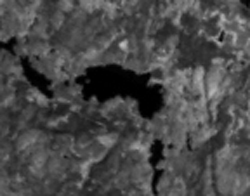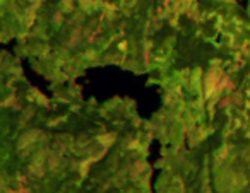 |
 |
The image on the left is of wavelengths in the near infra red only, while the one on the right is a combination of red, near infra red and middle infra red wavelengths, in false colours. The combination of these three makes the image easier to interpret. The dark areas in these images signify water.
In the image to the right, the darker shades of green signify coniferous forest, while brighter greens signify leafy forest or meadow. Areas that appear pink are either areas of wood felling, or cultivated land.
The image is from the Landsat satellite, and is taken in August over South-Eastern Norway.